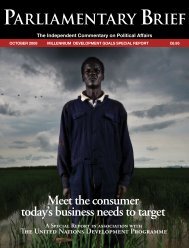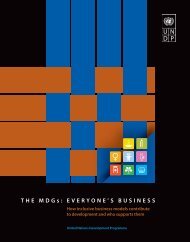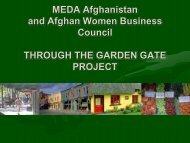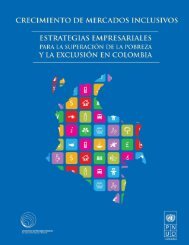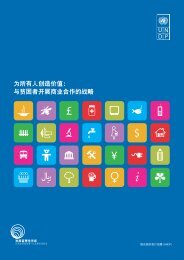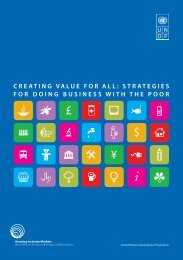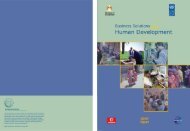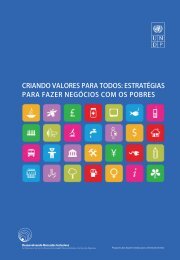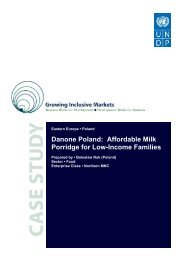Iran Kandelous 2011 - Growing Inclusive Markets
Iran Kandelous 2011 - Growing Inclusive Markets
Iran Kandelous 2011 - Growing Inclusive Markets
You also want an ePaper? Increase the reach of your titles
YUMPU automatically turns print PDFs into web optimized ePapers that Google loves.
a successful producer of detergents in <strong>Iran</strong>. The money generated through this business activitywas later used to finance the investments needed for establishing <strong>Kandelous</strong> Group.Table 2: Investment CostsActivityUS$ (estimate)Construction of Museum 1,000,000Hotel, park and restaurant 500,000Processing factory 340,000School, road, electric grids 800,000Agricultural land 100,000Source: CEO of <strong>Kandelous</strong> GroupThe herbal business has a much larger market compared to the rest of <strong>Kandelous</strong>’ activities. Themajor proportion of the Group’s revenue is generated via this line of business with averageannual sales of US$1.2 million. The income from this business unit supports investments andoperational expenses of the museum and cultural activities till they reach financial sustainabilityrequiring US$100,000 to US$200,000 per year. This business line has been profitable from thebeginning since it converts almost free-to-access plants or low-cost farm plants into high-valueaddedpackaged consumer goods. Since most of the investment by the Group were on land andprocessing facilities with low depreciation (and indeed value appreciation over time), theinvestment not only has kept its initial value but also has benefited the investor in the form ofcapital (asset value) gain and annual revenues.There is a synergy between the revenue models of different units. The herbal products introduce<strong>Kandelous</strong> and its village all over the country. In addition, the rustic museum and rural tourismfacilities bring visitors who buy herbal products from the outlet shop.Without the inclusive aspects of the business, the investment and revenue model of the companywould have been different. Museum and cultural activities are not profitable and cannot evengenerate enough revenue to cover their maintenance and day-to-day expenses. Nevertheless,Kandalous Group keeps the rural tourism facilities operational, because it is part of the founder’svision and also generates income directly for some 35 to 50 local workers and indirectly forseveral local families. Moreover, the company builds infrastructure which may be used by otherbusiness actors too. In a pure profit-oriented environment these investments may not be justified.Challenges during Initiation and Growth Stage“We had to slide the electricity generator on the snow for 15 km since there was no road orelectricity grid in the region”.Dr. Jahangiri, CEO of <strong>Kandelous</strong>Case Study ● <strong>Kandelous</strong> Agro-Industry Group 11






